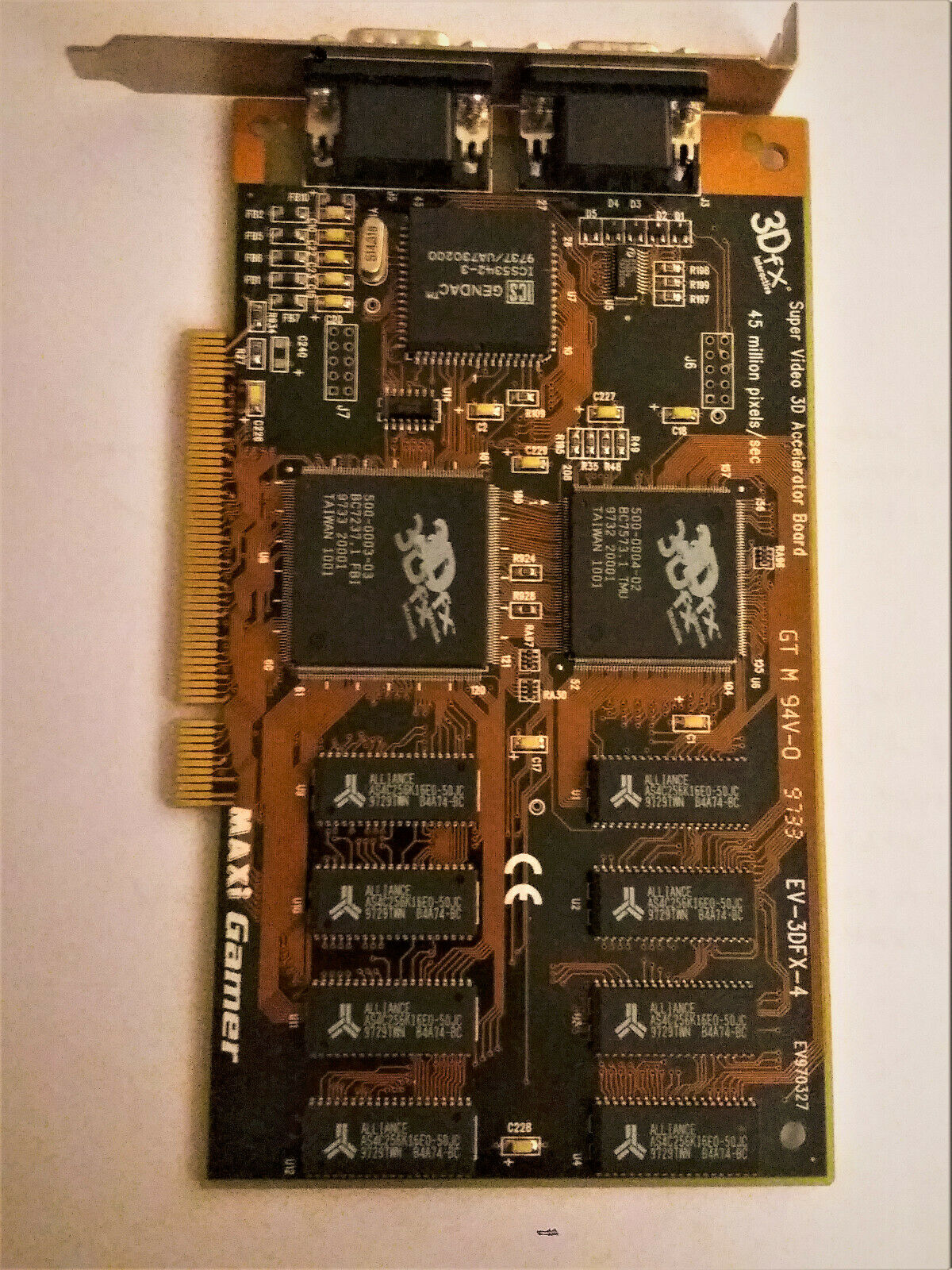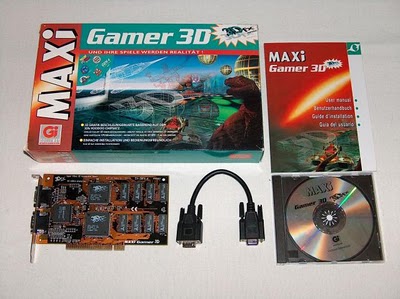 Maxi Gamer Phoenix Maxi Gamer Phoenix
Introduced: 1998
Bus: PCI
or AGP 1x
Chipset: 3Dfx Voodoo Banshee
Memory: 16 MB
Price when Launched: $109.99 (street price)
The Guillemot Maxi Gamer Phoenix is essentially a 3Dfx Banshee - an integrated 2D and 3D card. Compared to the 3Dfx Voodoo 2 (a 3D-only card), Banshee only contains a single texture unit. The 3Dfx-branded Banshee comes in with a clock speed of 100 MHz which produces a fill rate of 100 millions pixels per second. While this is 10% faster than the Voodoo 2 (to try to make up for its single texture unit compared to V2's two texture units), it does use the AGP 1x bus which can only transfer at a maximum speed of 66 MHz. Furthermore, the standard 3Dfx Banshee doesn't support AGP side-banding so is slower than an equivalent PCI card.
Enter the Maxi Gamer Phoenix, which is available in both AGP 1x and PCI versions of the 3Dfx card. This card is ideally suited to a lower-end gaming system of the era, such as a Pentium II 233-300 rather than a Pentium II 400 or 450. For these higher-end systems you're better off going for a Riva TNT-based card or an S3 Savage 3D. For the very best image quality of this era, go with a Matrox G200.
On the 2D side, it supports resolutions up to 1600 by 1200 at a 75 Hz horizontal refresh rate.
Where possible go for the PCI-based version of this card to avoid the poorer performance of AGP 1x.
It supports Direct3D, OpenGL and GLiDE.
"This attractively-priced card delivered a combination of top-flight performance and outstanding display quality across the spectrum of our objective and subjective tests. It's a good deal - and a sure bet for everything from business to gaming.
If you are about precise control over the screen image, you'll like the Guillemot drivers. An easy-to-use, tabbed Advanced Display Properties screen lets you tweak and tune a host of settings for 2-D, GLiDE/OpenGL, and Direct3D modes. On the downside, the bundle does not include a software DVD player, and the company does not offer a dedicated MPEG decoder daughtercard.
Like other Banshee-based accelerators, the Guillemot Maxi Gamer Phoenix
generally placed in the top group of finishers. It was the fastest PCI card on our 3-D benchmark tests and scored near the top on our 2-D suite. Like other Banshee-based products, in quality testing it did prove unable to perform certain operations, including a small set of MIP-mapping, texture-mapping, fogging, and pixel-blending functions.
Still, during subjective game-play testing, the Phoenix shone. If you're looking for a combination of excellent performance and rock-solid displays, this may be the card for you."
PC Magazine, December 1998
|
 Maxi Gamer Cougar Maxi Gamer Cougar
Introduced: January 2000
Bus: PCI or AGP 4x
Chipset: nVidia RIVA TNT2 M64
Core Clock: 125 MHz
Memory Clock: 150 MHz
Price when Launched: $95
The Guillemot Maxi Gamer Cougar is their branded version of the nVidia RIVA TNT2 M64. Just as with the Xentor 32, Guillemot was quick out of the gate to support the M64 upon its release in October 1999, and chose to create the Cougar both for the PCI bus and the much more commonly used AGP 4x bus at the time. The PCI variant is much more rare - in fact, very few RIVA TNT2 cards were produced for the PCI bus.
The TNT2 M64 chipset used a 64-bit memory pathway (half that of the standard TNT2), and hence was designed as a more budget-oriented offering. Given the low budget and slower speeds, the cards came only with passive cooling via a heatsink over the main nVidia chip.
Guillemot released two versions of this card: the Maxi Gamer Cougar and the Maxi Gamer Cougar Video Edition. The former was designed for the cost-conscious gamer while the latter was designed more for video editing, so competed with the ATI All-in-Wonder and Matrox Marvel-series of cards. It came with TV-out for PAL and NTSC formats, a DVI output port to connect to an LCD flat panel as well as a video-in port. |
 Guillemot Corporation
Guillemot Corporation





